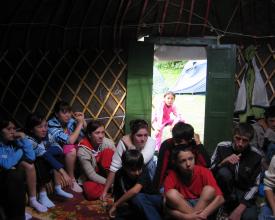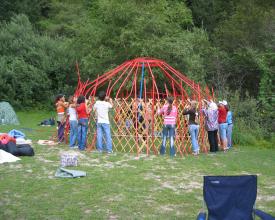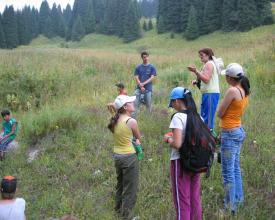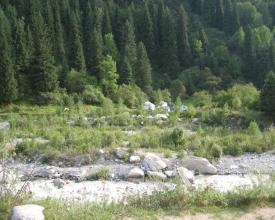The impact of ecotourism on changing perceptions about a PA
Full Solution

Children listen to the educator about ecology
Dilya Woodward
The Almaty Nature Reserve in Kazakhstan is an attractive destination for ecotourists due to its rich biodiversity, modern tourism infrastructure in nearby city of Almaty and international flight connections. Although met with some local resistance when created due to imposed restrictions, a three pronged strategy focusing on environmental, educational and public engagement has improved relations with communities and the reserve now welcomes ecotourists every year and hosts annual eco events.
Last update: 29 Mar 2019
3596 Views
Context
Challenges addressed
lack of ecological awareness, limited funding, low wages, negativity to protection regime
The main challenge in promoting ecotourism activities in the reserve are linked to limited ecological awareness of the local population, lower standards of living comparing to metropolitan areas and negative perception of the protected area that was formed due to the conservation regime.
Location
Almaty Nature Reserve, in the town of Talgar (near Almaty City), Kazakhstan
West Asia, Middle East
Process
Summary of the process
Ecocamps are used as a dialogue platform between local population, e.i. children of Talgar and the Reserve’s staff. By engaging in different activities at the ecocamp, children learn about biodiversity of the PA, about the threats on endangered species, they acquire new skills like setting up a tent, cooking in the field etc. When children return home, they tell their parents about activities that they were engaged in. Parents, in their turn, start developing a connection to the nature of the area that they live in and feel favorable to the Reserve’s staff for taking time and efforts in educating children and providing activities for summer holidays. By engaging different stakeholders and media representatives, the image of the PA and the main messages get distributed to the wider audience. The media coverage then helps the Reserve’s staff to build a profile that, in turn, helps in obtaining further funding for research.
Building Blocks
Building links with local schools
The purpose of this building block is to engage teachers and students from local schools in environmental protection. Members of staff of the reserve reached an agreement with the management of local schools to incorporate teaching hours in subjects such as biology, ecology and nature study by staff members of the reserve as well as planned visits to the reserve’s museum. The tandem between teachers and members of staff allowed to not only improve the environmental education in school children, but also to use the nature museum of the reserve as a place for children’s practical lessons, where they study the animals and plants of the area.
Enabling factors
Openness of the Reserve’s members of staff to innovative activities
Good communication skills of the members of staff
Ability to influence and persuade decision makers
Lesson learned
They key lesson is to contact local schools early in the year so that they include classes in the Reserve in their study plans and curriculum.
Resources
Engaging stakeholders, media representatives and other PAs
The purpose of this building block is to have the agenda of the protected area current among stakeholders and participants.
The Reserve’s staff engaged with different stakeholders on a strategic and long-term basis. These included: Directors of Schools, representatives of media (including National Media outlets), sponsors (who provided prizes for children’s competitions). The stakeholders were invited to the events because the events addressed their own agenda and because they were involved in the atmosphere of the celebration (music, colorful traditional costumes etc.)
Enabling factors
Extensive experience and creativity of the Reserve’s members of staff
Personal connections with journalists
Passion in reserve staff members for their work
Lesson learned
It is important to maintain good relations with stakeholders– for example, send Christmas cards, Nauryz celebration cards etc.
Conservation of rare species by engaging in ecotourism
When the ecological awareness of the local population is high enough, they understand that preservation of rare species of plants and animals will attract more ecotourists to the Reserve. That is why guest house owners actively participate in the programmes for the development of ecotourism, renovate guest houses, produce local souvenirs, grow local vegetables and fruits to sell to ecotourists.
Because locals know the trails in the Reserve well, they know where rare snow drops grow, where mountain goat trails are, their support and “buy-in” is very much needed for conservation purposes. Only by joining efforts, the common goals can be reached.
Enabling factors
The conditions include continuation of promoting ecotourism benefits, engaging local community in the Reserve’s events and, if possible, planning meetings, capacity building for guest house owners on service management, language courses, food safety standards etc.
Lesson learned
n/a
Summer ecological camp for children
Ecotourism is strictly limited in the reserve due to its seasonality. In winter, ecotourism is not possible due to snow storms and snow falls. In spring, it is avalanches warning season. In the end of spring and all summer there is tick warning and increased risk of mudflows. Therefore, the most suitable season for ecotourists to visit is August to October. More than 1000 people visited the reserve from 2006.
In 2003 first ecological camp hosted 100 students during one month in August. Since then, the Reserve welcomes ecotourists every year. The number of participants varies between 100 to 125 in one season and to 35 in 2008. Children who come to an ecocamp not only enjoy outdoor living in tents, but also learn a lot about the flora and fauna of the reserve from the daily classes given by staff of the reserve. At the end of their stay, children share their impressions of participating in the ecocamp in their drawings, questionnaires and stories to family members and peers.
The ecological club “Talhis” is functioning in the reserve since 2002. Its main activities are directed towards raising ecological awareness among youth, working with local communities and attracting attention of the relevant bodies to the environmental issues.
Enabling factors
Enabling conditions include subsidized vouchers for children to participate in the ecocamp, availability of the experienced and knowledgeable Reserve’s staff and availability of transport and other equipment such as tents, tables, sleeping bags etc.
Lesson learned
We learned that it is important to develop an agreement with a transportation company that has four by four vehicles in advance. Also, the first ecocamps were conducted in June, however, this month is not optimal for ecocamps due to mudflows threat, ticks and low temperatures in the mountains at night. The optimal month is August. When ecocamps were conducted in June all the children had to be vaccinated against Lime disease. When ecocamps are conducted in August, such vaccinations are not necessary.
Impacts
Regulated ecotourism activities proved to be a good solution to overcome the challenges that the management of the reserve faced.
The positive impacts of ecotourism include:
- Closer collaboration between members of staff of the Reserve and local schools and colleges
- Deeper engagement of local population in such initiatives as March of Parks, Birds Day, Day of Snowdrops etc.
- Better standards of living of local population
- More opportunities for locals to develop small businesses such as felt making for souvenirs, dairy production etc.
- Increased environmental awareness of youth in Talgar town
- Lesser involvement of local population in illegal activities (picking endangered species of plants and capturing wildlife species)
One example of the impact includes such important initiatives as “March for Parks”:
Since 1996, members of staff take an active part in the international rally “March for Parks”. This initiative has grown from a one day event to a large scale event of national significance that attracts a lot of attention from the media and reaches more than 10,000 people in two months. In 2010 Almaty Nature Reserve won the first prize and in 2011 members of staff received another award – for the best film.
Beneficiaries
Government authorities, administration of the reserve, members of staff of the reserve, local population, school teachers and students
Story
In the city of Talgar there is a small paradise with roses, fruit gardens and vegetable patches surrounded by fir trees and inhabited by squirrels, pheasants and hedgehogs. The owners of this paradise are children - young naturalists of the "Society of Young Ecologists" and their leader for the past 25 years – Mamed Makhmudov.
Mr Makhmudov and his young ecologists are well known in the region and abroad. They are frequent winners festivals, contests, forums, scientific competitions. No event in the town takes place without their participation.
The 3 ha of land, former monastery in pre-Soviet times, is its own world. Each pupil has his duties – to care for the flowers, to dig soil, to water vegetables. Children take turns in order to develop diverse skills.
There are currently 700 members in the society. But the grounds are too small to receive all its members at once. Therefore, an average of 20-30 children come each day. Mr Makhmudov notes: “By establishing close ties with plants and animals, children open their true souls, they become kinder, passionate and honest. Many of them come from underprivileged families. For me the most important thing is that children feel that they are bringing positive changes to the society and that their work is needed”.
Artur Albrant studies the indigenous type of apples “Aport” for the past 5 years researches the behavior of wild bees. Ilya Sheglov is the winner of national Competition of Small Academy of Sciences. He studies the purple willow, an aboriginal specie of Talgar mountains.
The young environmentalists are preparing for the most anticipated event of the year - the traditional ecocamp in Almaty State Reserve. It is a time filled with not just a romance with hiking, swimming in mountain streams and other attributes of camp life in the mountains. An active research work is carried out under the supervision of the Reserve staff and the Ile-Alatau National Park. The Reserve members of staff take care of children’s safety, transportation and equipment (partially) according to a 3-way agreement between the Reserve, National Park and the Society.
About 70% of graduates of the Society become teachers, medical doctors, biologists, rangers. For example, Zh. Dirbayeva and K. Pichugina became winners of the national scientific competition “Daryn” and received grants to study at the Medical University.
“Young naturalists are the most grateful students and they are my life’s mission” – said Mamed Makhmudov.
Connect with contributors
Other contributors
Dilya Woodward
Al-Farabi Kazakh National University
Ms Alexandra Vishnevskaya
Almaty Nature Reserve





